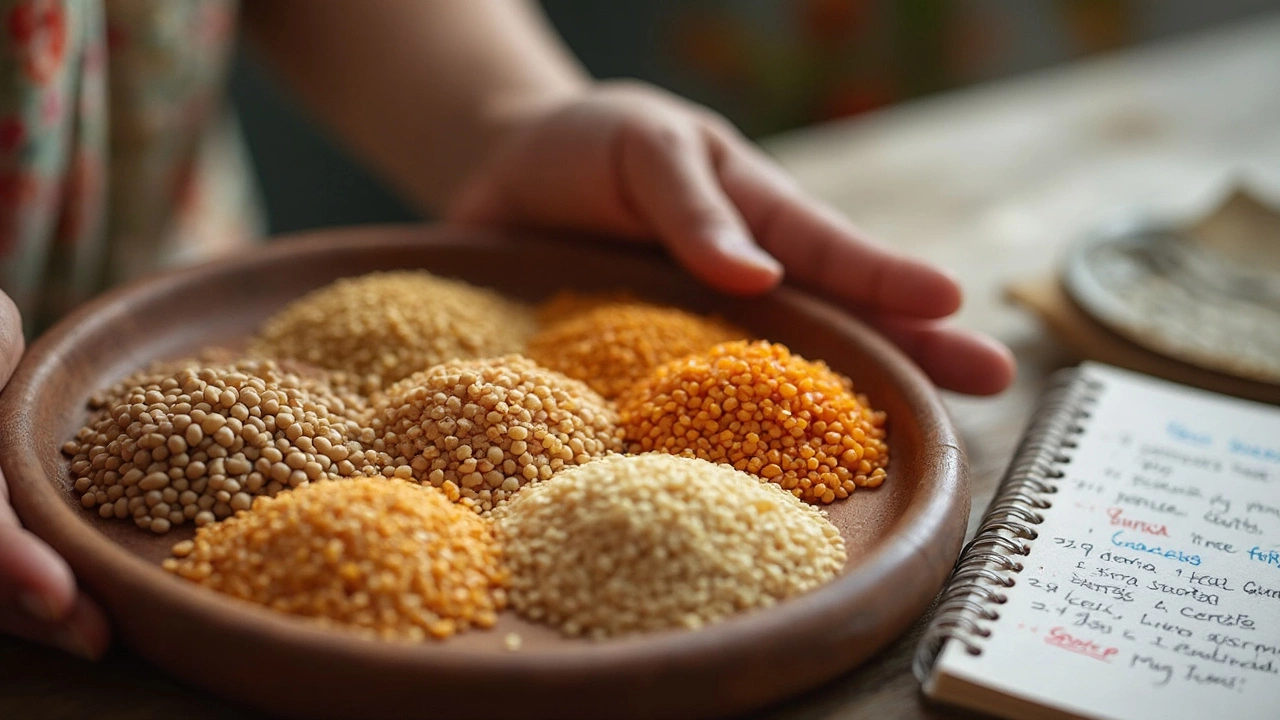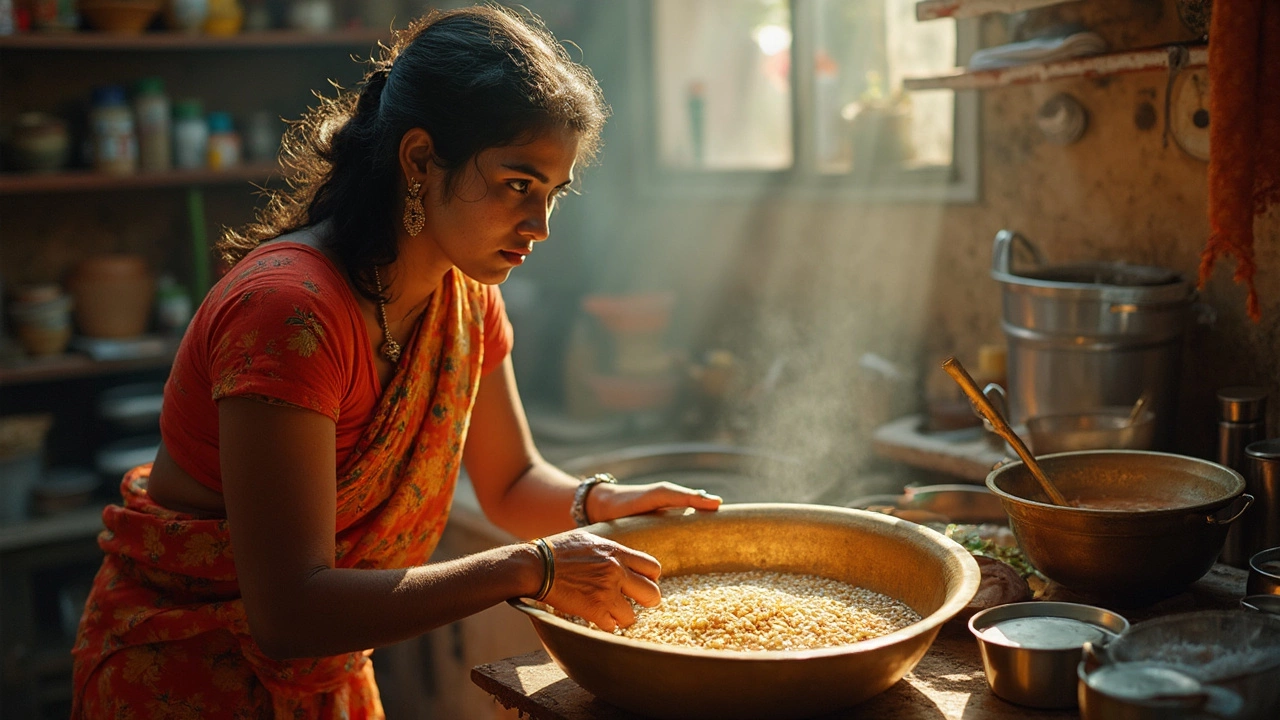Urad dal is pretty much non-negotiable for dosa—skip it, and you’re left with floppy crepes instead of those crisp, golden beauties. But soaking urad dal overnight for dosa? That’s a common move, especially if mornings get busy. So, is it actually good for your batter or are you risking a mushy mess?
Soaking isn’t just about softening the dal. It kickstarts fermentation, helps the dal grind up smooth, and gets the good bacteria going so your batter can puff up nicely. But yes, there’s a fine line between perfectly soaked and over-soaked, and it matters for your final result. Got an extra hot and humid night? That can speed things up even more, changing how much soaking is too much.
If you’ve ever woken up to a batter that smells weird or feels slimy, you’re not alone. Plenty of home cooks have made this mistake, especially during warmer months. But don’t worry—there are easy workarounds and smart tips to make sure your urad dal gives you a winning batter every time, without any last-minute drama.
- Why Soaking Urad Dal Matters
- Is Overnight Soaking Too Long?
- Best Practices for Perfect Dosa Batter
- Troubleshooting and Handy Tips
Why Soaking Urad Dal Matters
If you want crisp dosa that stays soft inside, soaking matters more than you might think. Urad dal on its own is tough and kinda chalky. When dry, it just won’t break down properly in your grinder. But a good soak? That gives your dal the perfect texture for smooth grinding, which is step one for a killer dosa batter.
Let’s get practical. Soaking urad dal hydrates it, making it double or even triple in size. This isn't just about getting soft—it's about prepping those little lentils to blend up fluffy, not gritty. That smoothness is what actually traps the air and water you need for proper fermentation and a bubbly batter.
It also helps release natural enzymes. These help ferment the batter and break down the dal a bit more, making it easier to digest and giving your dosa that slightly tangy flavor that’s so good. Skip the soak, and you’ll get flat, dense dosas that are nowhere near what you want.
Here’s a breakdown of why you should always soak:
- Soaked dal grinds up much, much smoother.
- The fermentation process gets a big boost from the extra hydration.
- Proper soaking helps batter rise better for fluffier dosas.
- Dosas made from soaked dal cook up lighter and crispier on the pan.
So yes, giving urad dal a soak isn't just unnecessary busywork—it's the backbone of every good urad dal dosa batter. A little patience here saves a lot of disappointment later.
Is Overnight Soaking Too Long?
Most folks soak urad dal overnight without thinking twice, mainly because it’s easy to set and forget. But here’s the thing—soaking for 8 hours is usually just right, especially if your kitchen is cooler. Go past 10-12 hours and you’re heading into risky territory, especially during hot or humid summer months. The dal can start to break down, making your urad dal slimy or developing a funky smell that totally ruins dosa batter.
Scientists who study food fermentation agree: soaking times always depend on temperature. In cooler weather, overnight soaking works fine, but at 28°C (82°F) and above, things can move way faster than you think. Here’s how different soak times stack up:
| Room Temperature | Recommended Soak Time | Potential Issue If Exceeded |
|---|---|---|
| Below 22°C / 72°F | 8-10 hours | Little to no problem |
| 22-28°C / 72-82°F | 6-8 hours | Bit slimy, sour taste |
| Above 28°C / 82°F | 4-6 hours | Too soft, unpleasant smell, batter doesn't ferment well |
If your kitchen is warm, stick to a shorter soak and check the dal after about 6 hours. The grains should be plump but not mushy. If you touch it and it feels sticky or greasy, it’s a sign you went too long. A lot of people put their soaking urad dal in the fridge overnight—it works! It slows down fermentation, so you still get the soft texture without that off-putting smell or taste.
Don’t forget, fresher urad dal soaks up water better, while older stock might need less time. Always rinse it well before and after soaking to keep the batter fresh. If you end up soaking too long by accident, you can still try to salvage the dal by washing it in cold water before grinding, but if the smell is off, it’s safer to start over.
- Use a timer or reminder on your phone so you don’t over-soak.
- For summer or tropical climates, try soaking in the afternoon and grinding before bed.
- If you can’t avoid long soaks, pop the bowl in the fridge after 6 hours.

Best Practices for Perfect Dosa Batter
Nailing dosa batter isn’t tricky, but you need to get a few steps right, especially when working with urad dal. The soak, the grind, and the fermentation—each stage can mess things up or take your dosas to the next level.
Here’s how to make sure your batter comes out just right every time:
- Soak the urad dal and rice separately: Most folks use a 1:3 ratio—1 cup urad dal to 3 cups rice. Soak both for at least 6 hours, but overnight is fine if your kitchen is cool (under 28°C/82°F). Warm kitchens speed everything up, so 4-6 hours is plenty if it’s hot.
- Use fresh, cool water: Water quality can make or break fermentation. Don’t use chlorinated tap water if you can avoid it; filtered or boiled (then cooled) works best.
- Grind smooth, but don’t overdo it: Use as little water as needed for grinding. The goal is super-smooth urad dal paste and slightly grainy rice. A wet grinder beats a blender, but if you’re using a mixer, take it slow and keep scraping the sides down.
- Mix and ferment in the right vessel: After grinding, mix the batters well—in fact, beating air in helps for fluffier dosas. Always ferment in a deep, roomy bowl since batter can double in size. Cover it loosely, not airtight, because the good bacteria need some air.
| Ingredient | Ideal Soaking Time | Grinding Texture |
|---|---|---|
| Urad dal | 6-8 hrs (4-6 hrs if hot) | Super smooth |
| Rice | 6-8 hrs | Slightly gritty |
Don’t salt the batter before fermenting. It slows down the rise. Add salt (about 1 tsp per cup of rice) just before making dosas, after the batter is fluffy and doubled.
If you want consistent results, keep the soaked dal cool. In summer, pop the soaking dal in the fridge after 4 hours if you’re not grinding right away. And always wash both rice and dal a few times before soaking; it gets rid of extra starch and any dirt.
And here’s a quick tip: A handful of cooked rice or poha (flattened rice) blended into your batter boosts that signature softness and golden color you get at South Indian eateries.
Troubleshooting and Handy Tips
Sometimes, even when you do everything right, urad dal can throw you a curveball. Maybe you forgot about it overnight, or your kitchen turned into a sauna. Here are the problems you might face with urad dal soaking and how to tackle them without starting over.
- Batter turned slimy or smells off? This usually happens if you soak for more than 10-12 hours in hot weather. If it smells really sour or feels too sticky, it’s safest to toss it and start fresh. Otherwise, you can rinse the dal again and grind, but don’t expect perfect dosas.
- Dal is still hard after soaking? Old stock of dal often needs more time. Try soaking in warm (not hot) water or leave it for another couple hours. Pre-soaking in a thermos helps maintain a steady temperature for tough dals.
- Batter isn’t fermenting? Chillier weather slows everything down. Try placing the batter in your oven with just the light turned on, or set the bowl on top of your fridge where it’s a little warmer. Toss in a pinch of methi (fenugreek) seeds next time—you’ll get better fermentation and a softer texture.
- Dosa comes out dense and flat? Either your batter was too thick, the dal didn’t soak long enough, or fermentation didn’t happen. Add a splash of water, mix well, and let it sit a bit longer to rise.
Want to avoid these stressors altogether? Stick to this cheat sheet for good soaking times based on the weather:
| Weather | Soaking Time | Notes |
|---|---|---|
| Summer (hot & humid) | 6-8 hours | Check by pressing a dal; it should split easily. |
| Spring/Fall (mild) | 8-10 hours | Stir if soaking longer to avoid fermentation at this stage. |
| Winter (cold) | 10-12 hours | Use slightly warm water to start. |
One last tip—always rinse urad dal after soaking, right before grinding. This clears any leftover smell or sourness and helps you get fluffier batter. Also, when grinding, add water slowly instead of dumping it all at once; this avoids runny batter that won’t hold up on the pan. With these fixes, you’ll have crisp, tasty dosas every time, no matter what the weather or dal quality throws at you.
